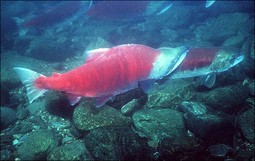forum
library
tutorial
contact

Federal Judge to Hear
Arguments on Salmon Recovery
by Aaron KunzOregon Public Broadcasting, May 9, 2011
|
the film forum library tutorial contact |

|
Federal Judge to Hear
by Aaron Kunz |
 A district judge in Portland hears oral arguments Monday in a case that's nearly a decade in the making.
A district judge in Portland hears oral arguments Monday in a case that's nearly a decade in the making.
The endangered Snake River sockeye salmon is at the heart of this. They are on the brink of extinction and the only way they have survived is by human intervention.
But not everyone is on the same page when to comes to salmon recovery.
Agencies in Washington, Oregon and Idaho, along with the federal government, have spent millions of dollars tagging, watching and working to restore salmon habitat.
Pete Hassemer has played a role in this. He is a fish manager with the Idaho Department of Fish and Game.
Here on the banks of a small steam that feeds the Clearwater River, Hassemer watches as fish and game officers tag young fish release them back to the water to begin their journey down stream.
Pete Hassemer: "And so the first part of that is when they encounter these reservoirs on the lower Snake and the Columbia, how we move them past the dams."
Salmon are unique because at a young age they begin a 1,600-mile round-trip journey to the Pacific Ocean. Then in a few years as adults they begin the grueling trip back to Idaho - uphill 6,500 vertical feet.
In their way, four dams on the Lower Snake River and four on the Lower Columbia make that journey more difficult.
NOAA Fisheries is the federal agency that initiated the recovery plan for the sockeye salmon. That plan is called a biological opinion and that is what is being reviewed by Judge James Redden.
Tom Stuart of Idaho Rivers United explains that narrow focus.
Tom Stuart: "The biggest question is whether or not the federal salmon management plan, the biological opinion, complies with the Endangered Species Act or not. That's fundamentally where we are."
The plan has twice been rejected by the court - rule insufficient in 2000 then again in 2004. Part of the current recovery plan is the breeding of millions of hatchery fish.
Few wild salmon return to Idaho to complete their life cycle; less than one percent. Even the hatchery fish struggle to return. Last year, only a couple thousand made their way back to the Snake River and Idaho's Redfish Lake.
Pete Hassemer: "There is no silver bullet yet that's going to solve everything but we're certainly making advances in recent years. And some of the responses that we've seen in the past years in the fish populations have been positive."
While there is no silver bullet, Pete Hassemer says there is evidence that allowing more water to spill over dams has a positive impact on migrating salmon.
Bonneville Power Administration spokesman Michael Milstein says fish that go over the top of dams are less likely to survive. Instead, he says the BPA has made improvements to dams.
Michael Milstein: "There has been a lot of changes on the inside. And so the fish are moving through them much more safely and at a much higher percentage than they ever have before."
But Tom Stuart of Rivers United disagrees. He says dams are the biggest problem salmon face. He says BPA has fought to reduce spill despite potential benefits.
Tom Stuart: "We think the current spill is a floor not a ceiling. It should be enhanced for anyone who's serious about keeping dams in place regardless of their value."
The latest biological opinion has also been revised in ways that have gained support from some at the table. BPA plays a big part of that revision, which includes funding habitat improvements to the tune of $100 million.
The BPA's Michael Milstein says he hopes the judge will take into account not only the salmon but also the role dams play in the Northwest.
Michael Milstein: "Well, those dams provide about a third of the power to the Northwest. And just as important is - that power is clean power."
Judge Redden sent a letter last week posing several questions to lawyers involved with the biological opinion. One of those questions is whether the steps taken so far to save the salmon are enough to prevent its extinction.
If Redden is not satisfied with the answers he receives, he could order the government to undertake more far-reaching action. One step he can't order is the removal of dams.
That's a power only Congress holds.
Related Pages:
FEEDBACK: Snake River Sockeye Recovery Plan by Scott Levy, Columbia Basin Bulletin, 11/19/10
bluefish.org does the research handout provided at Federal Court's Closing Arguments by bluefish.org, 5/9/11
Oops! It turns out that handing these out in a federal courthouse is illegal and the bailiff asked me to stop after a complaint was made by an unknown attendee.
Breaching the Dams? by Peter DeFazio, Eugene Weekly, 5/3/11
DeFazio's Role in the Columbia Basin Salmon Crisis by Sheena Moore, Eugene Weekly, 4/21/11
Saving Salmon: Time to Get Out of the Courtroom and Into the River by Doc Hastings & DeFazio, The Oregonian, 3/11/11
learn more on topics covered in the film
see the video
read the script
learn the songs
discussion forum
